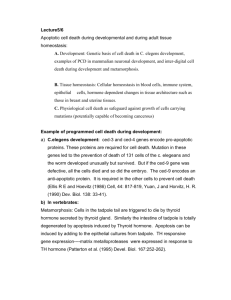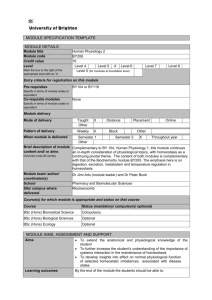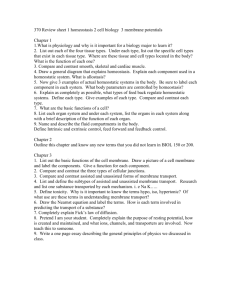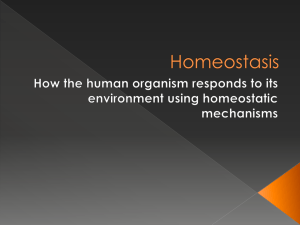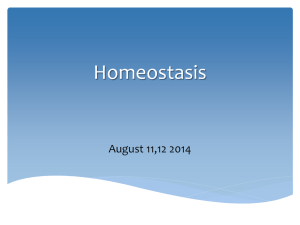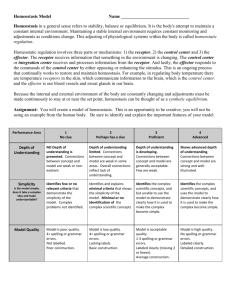Chapter 1 - Moorpark College
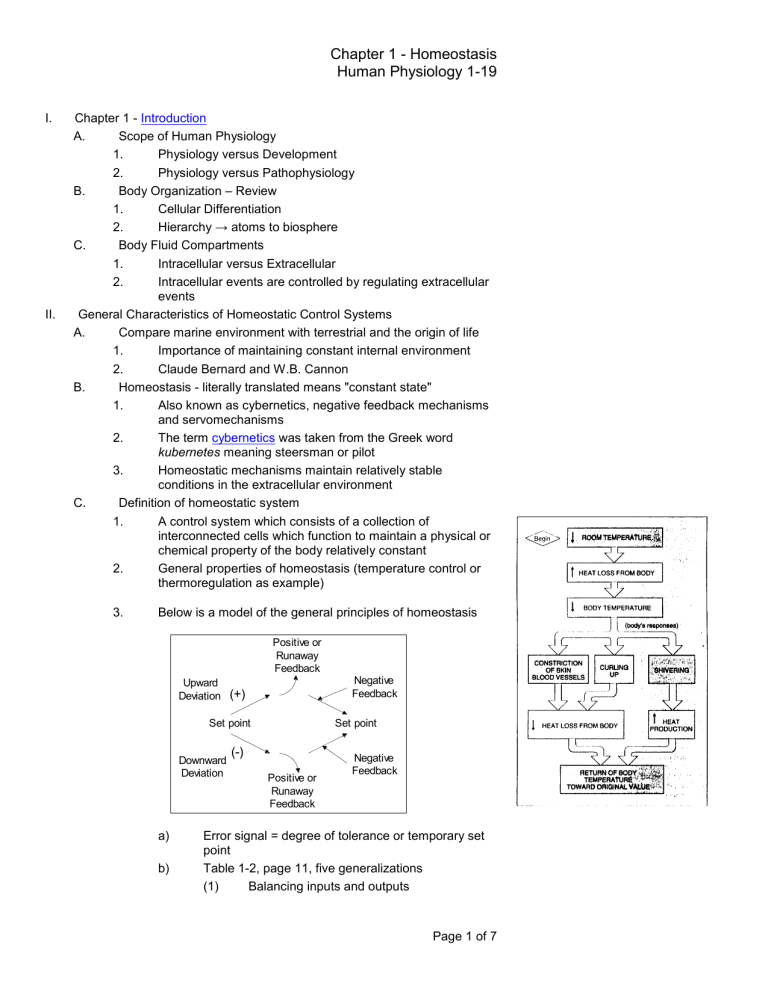
Chapter 1 - Homeostasis
Human Physiology 1-19
I. Chapter 1 - Introduction
A. Scope of Human Physiology
1. Physiology versus Development
B.
2. Physiology versus Pathophysiology
Body Organization – Review
1.
2.
Cellular Differentiation
Hierarchy → atoms to biosphere
C.
A.
Body Fluid Compartments
1.
2.
Intracellular versus Extracellular
Intracellular events are controlled by regulating extracellular events
II. General Characteristics of Homeostatic Control Systems
Compare marine environment with terrestrial and the origin of life
1. Importance of maintaining constant internal environment
B.
2. Claude Bernard and W.B. Cannon
Homeostasis - literally translated means "constant state"
1. Also known as cybernetics, negative feedback mechanisms and servomechanisms
2. The term cybernetics was taken from the Greek word kubernetes meaning steersman or pilot
C.
3. Homeostatic mechanisms maintain relatively stable conditions in the extracellular environment
Definition of homeostatic system
1.
2.
A control system which consists of a collection of interconnected cells which function to maintain a physical or chemical property of the body relatively constant
General properties of homeostasis (temperature control or thermoregulation as example)
3. Below is a model of the general principles of homeostasis
Positive or
Runaway
Feedback
Upward
Deviation
(+)
Set point
Negative
Feedback
Set point a) b)
Downward
Deviation
(-)
Negative
Feedback
Positive or
Runaway
Feedback
Error signal = degree of tolerance or temporary set point
Table 1-2, page 11, five generalizations
(1) Balancing inputs and outputs
Page 1 of 7
Chapter 1 - Homeostasis
Human Physiology 1-19
B. a) b) c) d)
(2)
(3)
Negative feedback
response is in opposite direction to deviation
Do not maintain absolutely but rather within a variable range depending on importance of homeostatic mechanism
(4)
(5)
Some set points can be reset
Homeostatic mechanisms operate on a hierarchy of importance
Set point = operating point
Any return to the set point is called negative feedback
Any deviation that causes further deviation is termed positive or runaway feedback
Not all negative feedback is good and not all positive feedback is bad - depends on the parameter in question - the terms positive and negative do NOT connote benefit or harm, e.g. Blood clotting
positive and negative feedback e)
III. Components of Homeostatic Systems - Text page 11
A. Reflexes
genetically determined response to stimulus
1. Stimulus-response sequence a) Most are inborn, automatic and the individual is not aware of their action, they are involuntary b) Others are learned or acquired like driving a car
2.
Feedforward regulation anticipates changes in a regulated variable, improves the speed of the body's homeostatic responses, and minimizes fluctuations in the level of the variable being regulated
(1)
(2)
Involves an initial set of receptors, e.g., skin thermal receptors then core thermal receptors
Conditions the body for further adjustments
Components of reflex arc, Figure 1-5, page 12 a) Receptor b) c)
Afferent pathway (input)
Integrating center
3.
4. d) e)
Efferent pathway (output)
Effector
Examples - Hypothermia, Figure 1-6, page 12
Questions about homeostatic reflexes - Table 1-3, page 13
(five questions) a) What parameter is being maintained? b) c)
What are the afferent and efferent mechanisms?
Where and what are the receptors? d) e)
Where is the integrating center?
What are the effectors?
Local homeostatic responses
Page 2 of 7
Chapter 1 - Homeostasis
Human Physiology 1-19
C.
1.
2.
3.
Very important
Provide individual areas of the body with mechanisms for local self-regulation (local vasodilation)
Intercellular chemical messengers
1.
Local means that the homeostatic mechanism doesn't involve a long pathway or an integrating center
2.
For reflexes to work internally there must be a mechanism for relaying information such as hormones to its “ target cell ”1
Neurotransmitters, Figure 1-7, page 14
3. a) b)
Means by which neurons communicate
Chemicals that is secreted by neurons but enter the blood stream are properly known as hormones or neurohormones, NOT neurotransmitters
Paracrine agents (local hormones) a) b)
Chemical messengers involved in local responses
Paracrines effect cells close to themselves
4.
5.
6.
7.
Chemical substances that are secondary by-products of cellular activity can act as messengers a) They are not specific messengers as are paracrines, hormones and neurotransmitters b) Examples: potassium, hydrogen ion effects on vascular smooth muscle
Autocrines - A chemical secreted into the extracellular fluid surrounding the cell and act upon the cell that secreted it
These different substances can act in different modes depending on the homeostatic mechanism in question, i.e. somatostatin can act as hormone, paracrine (or autocrine) or neurotransmitter
Exceptions to circulating messengers a) b)
Gap junctions - direct transfer of information
Messenger may be embedded in plasma membrane
- example is found in immune function
IV. Processes Related to Homeostasis
A. Adaptation & Acclimatization - Text page 15
1. All physiological homeostatic mechanisms are inherited
B. a) Physiological mechanisms are developmentally determined and have critical periods
Genetically determined as function as time b) c) Critical period in during infancy and childhood and developmental acclimatization
2. There can be a wide variation of responsiveness due to
"conditioning"
Andes Indians, eg.
Biological rhythms - Text page 15
1 The term “target cell” is a misnomer and left over from before it was understood how hormones act upon the appropriate cells - more later
Page 3 of 7
Chapter 1 - Homeostasis
Human Physiology 1-19
C.
1.
2.
3.
Some homeostatic mechanisms operate on a cyclic basis, i.e. menstrual cycle
Innate such as circadian rhythm of body is 24 hours a) Entrainment - while rhythms are innate they can be influenced by external factors b) Experiment with light cycle and free-running rhythms c) c)
Studies on these cycles reveal much about work shifts and “jet lag”
See Figure 1-8, page 153 d)
Neural basis of body rhythms? a) Hypothalamus
pacemaker nuclei not understood b) One output to pineal gland that secretes melatonin
sleep cycle
A “feedforward” mechanism working in concert with homeostatic mechanisms
Apoptosis (regulated cell death) plays an important role in homeostasis by helping to regulate cell numbers and eliminating undesirable cells → Regulated Cell Death
1. It is obvious that the proliferation and differentiation of cells are important for the development and maintenance of homeostasis in multicellular organisms.
2. Virtually all cells have the ability to self-destruct by activation of an intrinsic cell suicide program. a) This type of cell death, termed apoptosis, plays important roles in the sculpting of a developing organism and in the elimination of undesirable cells
(for example, cells that have become cancerous), but it is particularly crucial for regulating the number of cells in a tissue or organ. b) A balance between cell proliferation and cell death normally determines the control of cell number within each cell lineage, both of which are regulated processes. For example, white blood cells called neutrophils are programmed to die by apoptosis 24 hours after they are produced in the bone marrow.
3. Apoptosis occurs by controlled autodigestion of the cell contents. a) b)
Within a cell, endogenous enzymes are activated that break down the cell nucleus and its DNA, as well as other cell organelles. Importantly, the plasma membrane is maintained as the cell dies so that the cell contents are not dispersed. Instead the apoptotic cell sends out chemical messengers that attract neighboring phagocytic cells (cells that "eat" matter or other cells), which engulf and digest the dying or dead cell. In this way the leakage of breakdown products, many of which are toxic, from apoptotic cells is prevented.
Apoptosis is, therefore, very different from the death of a cell due to externally imposed injury; in that
Page 4 of 7
Chapter 1 - Homeostasis
Human Physiology 1-19
4.
5. case (termed necrosis) the plasma membrane is disrupted, and the cell swells and releases its cytoplasmic material, inducing an inflammatory response, as described in Chapter 20.
All normal cells contain the enzymes capable of carrying out apoptosis means that these enzymes must normally remain inactive if the cell is to survive. a) In most tissues this inactivity is maintained by the constant supply to the cell of a large number of chemical "survival signals" provided by neighboring cells, hormones, and the extracellular matrix. b) In other words, most cells are programmed to commit suicide if survival signals are not received from the internal environment. For example, prostate-gland cells undergo apoptosis when the influence on them of testosterone, the male sex hormone, is removed. In addition, there are other chemical signals, some exogenous to the organism
(for example, certain viruses and bacterial toxins) and some endogenous (for example, certain messengers released by nerve cells and white blood cells) that can inhibit or override survival signals and induce the cell to undergo apoptosis.
It is very likely that abnormal inhibition of appropriate apoptosis may contribute to diseases, like cancer, characterized by excessive numbers of cells. a) At the other end of the spectrum too high a rate of apoptosis probably contributes to degenerative diseases, such as that of bone in the disease called osteoporosis. b) The hope is that therapies designed to enhance or decrease apoptosis, depending on the situation, would ameliorate these diseases.
See box below for further explanation.
Page 5 of 7
Chapter 1 - Homeostasis
Human Physiology 1-19
Also called Programmed Cell Death, in biology, a mechanism that allows cells to selfdestruct when stimulated by the appropriate trigger. Apoptosis is initiated for various reasons, such as when a cell is no longer needed within the body or when it becomes a threat to the health of the organism. Apoptosis is necessary in embryonic development as well as in the daily maintenance of a mature organism. The aberrant inhibition or initiation of apoptosis contributes to many disease processes, including cancer .
Embryologists in the early 20th century were familiar with the process of programmed cell death. They observed that as an embryo develops, many of its cells are sacrificed to create the final form of the organism. Not until 1972, however, did researchers John F.R. Kerr,
Andrew H. Wyllie, and Alastair Currie recognize the broader significance of this mechanism. They coined the term apoptosis from the Greek word meaning “falling off,” as leaves do in autumn, to describe this natural, timely death of cells. Apoptosis is distinguished from an alternate form of cell death, called necrosis, that results from injury.
Apoptosis is a normal physiological process that offsets cell proliferation. It is a genetically programmed event that can be set in motion by a variety of internal or external stimuli. A signal activates genes in the cell's suicide pathway which encode the proteins that destroy the cell's structural proteins and genetic material. A number of morphological changes occur in the apoptotic cell —e.g., the cell begins to shrivel and pull away from other cells, bubblelike formations appear on its surface, and chromatin (chromosomal DNA and protein) in the cell's nucleus condenses. The cell then either is consumed by other cells or breaks up into smaller pieces that are engulfed by scavenger cells. Cells in virtually all tissues may be sacrificed through apoptosis for the good of the organism. For example, the cells of the uterine wall undergo programmed death in the monthly menstrual cycle.
Various phenomena can disturb the regulation of the cell death pathway, causing too many or too few cells to die. Many types of disease result from such disruptions. If, for example, a mutation occurs in a gene that induces apoptosis , such as the tumour-suppressor gene p53, the cell that harbours the gene may fail to respond to the cue to die. As a result the cell may proliferate uncontrollably and form a cancerous tumour. In other cases a virus may interfere with the regulation of apoptosis , inducing healthy cells to die. This mechanism is believed to play a role in AIDS , the disease in which infection with the HIV virus results in the destruction of healthy white blood cells called T lymphocytes .
D.
E.
"Apoptosis." Encyclopædia Britannica. 2003. Encyclopædia Britannica Premium Service.
09 Aug, 2003 < http://www.britannica.com/eb/article?eu=3035
Aging and homeostasis
1. Aging is not a disease - it is the latter stages of development and is genetically determined
2.
3.
4.
Development patterns are NOT homeostatically controlled
Homeostatic mechanisms don't operate as well - start downhill at age thirty (30), that is the beginning of senescence
Aging is marked by a loss of cells by the body – a combination of less cell division and increased cell death
5. Basis of senescence isn't understood a) Recent study shows that if the studies of the aged are weighed in favor of those people who have not abused themselves they show much less decline in abilities. b) c)
Twin studies show about 1/3rd of aging is genetic and the other 2/3rds environmental
Non-human animal studies indicates that caloric restriction can prolong the life span in rats
Balance in the homeostasis of chemicals
1. Figure 7-8, page 156 - balance diagram
Page 6 of 7
Chapter 1 - Homeostasis
Human Physiology 1-19
2. a) b)
Net loss > net gain = negative balance
Net loss < net gain = positive balance c) Net loss = net gain = stability
Figure 7-9, page 157
shows adjustment to increase in sodium setpoint but the net effect is 2% increase in sodium levels because it is the net signal error
Page 7 of 7


